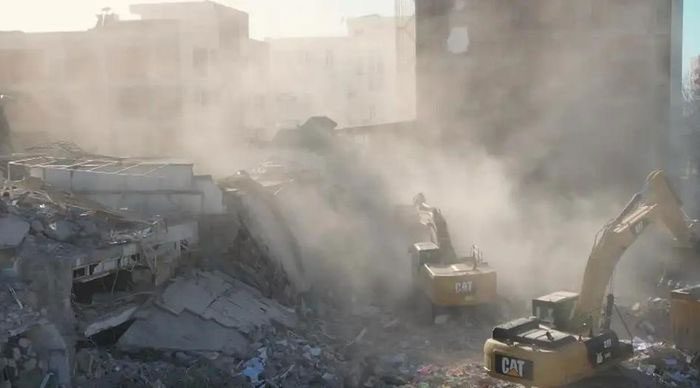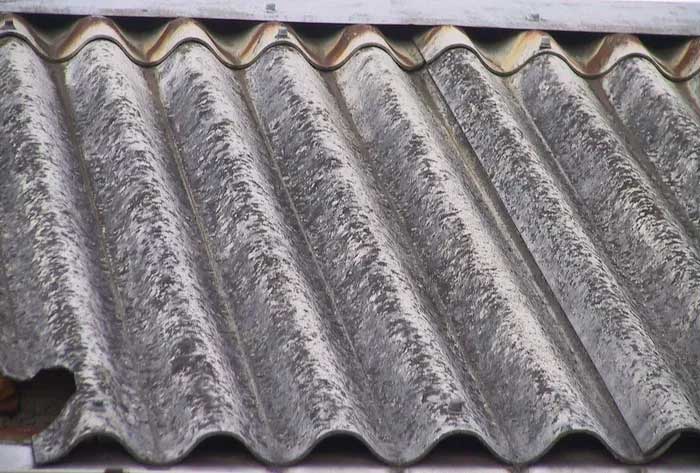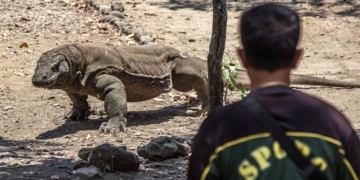A recent investigation conducted by the German newspaper DW has revealed that the rubble from the devastating earthquake in February this year in Turkey contains a significant amount of asbestos, posing a serious threat to the local population.
The Danger of the Massive Dust Cloud
In Hatay, southern Turkey, teams are still engaged in demolishing heavily damaged buildings following the earthquake that occurred on February 6, 2023, which resulted in tens of thousands of fatalities. Demolition workers are moving through the rubble, creating dust clouds that blanket the city.

Demolition teams clearing rubble after the earthquake in Hatay province, Turkey. (Photo: DW).
Some children walk through the debris looking for a place to play soccer. In doing so, they may be inhaling a silent killer: asbestos.
According to an exclusive investigation by DW’s Turkey Environment department, toxic construction materials have contaminated crops, soil, and debris in this key agricultural area, indicating a serious public health crisis is unfolding.
A group of experts from the Turkish Chamber of Environmental Engineers (UCTEA) collected dust samples in Hatay, which were then analyzed by AGT Vonka Laboratory and Engineering, an internationally recognized lab. The investigation confirmed the presence of asbestos in the area.
Public health experts warn that those living in the earthquake-affected area, including thousands of children, are at serious risk of developing lung and laryngeal cancers related to asbestos exposure. Mesothelioma, a particularly dangerous form of cancer, is another potential consequence of the toxins released after the earthquake.
Some experts suggest that a “secondary disaster” of toxic pollution could be even more severe than the earthquake itself. Mehmet Şeyhmus Ensari, a construction engineer and President of the Turkish Asbestos Removal Professionals Association, told Reuters: “With the most optimistic estimate, I can say that 3 million people will become ill.”
Dr. Özkan Kaan Karadag, a public health and occupational disease expert in Turkey, stated: “In the coming years, we may face the deaths of tens of thousands of very young people due to mesothelioma.”
From Miracle Material to Deadly Toxin
Once celebrated as a miracle material with many diverse uses, asbestos is now classified as a “carcinogen” by the World Health Organization (WHO). However, asbestos-containing construction materials are still found in many buildings in Turkey that were constructed before its sale was banned in 2010, although the exact numbers remain unclear.

A roofing sheet containing asbestos material. (Photo: Wiki).
Efforts to Mitigate Harm
Despite this, social organizations in Turkey are striving to combat concerns about asbestos. In April, the Hatay Bar Association and environmental and health organizations filed a lawsuit seeking to halt demolition activities in the city, but the case is still awaiting resolution after five months.
Ecevit Alkan from the Hatay Bar Association is one of the lawyers working to fight against malpractice in waste disposal. He has also fallen ill due to the dust.
Alkan points out a site near a high school with temporary container housing for earthquake victims and an irrigation channel for agriculture that he believes may be contaminated with asbestos dust. “It would be very risky to use this area as a landfill for both people and the environment,” he said.

A woman tries to avoid dust while passing by a bulldozer clearing rubble in the ancient city of Antakya, Hatay province, Turkey. (Photo: The Guardian).
Utku Firat, an environmental engineer involved in the research, states that the danger could be mitigated by removing asbestos materials before the buildings are demolished. Firat comments on demolition companies: “They not only fail to do this but even do not cover the trucks carrying the debris with tarps.”
Although the damage done so far is irreparable, some safety measures could at least alleviate some dangers for residents exposed to dust from the rubble.
“Face masks should be distributed to residents and workers in the area and they should be encouraged to use them. Communities most affected by dust need to be identified and relocated to safer areas,” advises Utku Firat.



















































